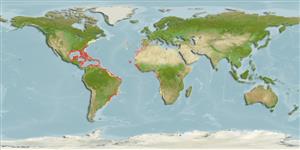Actinopterygii (ray-finned fishes) >
Tetraodontiformes (Puffers and filefishes) >
Balistidae (Triggerfishes)
Etymology: Balistes: Latin, balista, -ae = crossbowman. In Greek, ballo = to throw (Ref. 45335). More on author: Linnaeus.
Environment / Climate / Range
Ecology
Marine; reef-associated; depth range 2 - 275 m (Ref. 4727), usually 3 - 30 m (Ref. 40849). Tropical; 28°C - ?, preferred ?; 43°N - 35°S, 98°W - 14°E
Eastern Atlantic: Ascension, Cape Verde, and Azores (Ref. 7348); ranges south to southern Angola (Ref. 4420). Western Atlantic: Canada (Ref. 5951) to Massachusetts, USA and northern Gulf of Mexico to southeastern Brazil (Ref. 7251).
Length at first maturity / Size / Weight / Age
Maturity: Lm 23.5 range ? - ? cm
Max length : 60.0 cm TL male/unsexed; (Ref. 7251); common length : 30.0 cm TL male/unsexed; (Ref. 5217); max. published weight: 5.4 kg (Ref. 4699)
Dorsal
spines
(total): 3;
Dorsal
soft rays
(total): 29-32;
Anal
spines: 0;
Anal
soft rays: 27 - 29. Greenish or bluish gray on back, orange-yellow on lower part of head and abdomen, with two broad diagonal curved bright blue bands running from snout to below and in front of pectoral fins, the lowermost continuous with a blue ring around lips; a broad blue bar across caudal peduncle, and blue sub-marginal bands in median fins (Ref. 13442).
Found over rocky or coral areas (Ref. 5217). May form schools, sometimes solitary over sand and grassy areas. Feeds mainly on benthic invertebrates (Ref. 4727). It preys on sea urchins by blowing water to overturn it and then attacks it where the spines are short (Ref. 9710). Excellent food fish but occasionally can cause intoxication due to the liver.
Robins, C.R. and G.C. Ray, 1986. A field guide to Atlantic coast fishes of North America. Houghton Mifflin Company, Boston, U.S.A. 354 p. (Ref. 7251)
IUCN Red List Status (Ref. 115185)
CITES (Ref. 94142)
Not Evaluated
Threat to humans
Poisonous to eat
Human uses
Fisheries: minor commercial; gamefish: yes; aquarium: commercial
More information
ReferencesAquacultureAquaculture profileStrainsGeneticsAllele frequenciesHeritabilityDiseasesProcessingMass conversion
Tools
Special reports
Download XML
Internet sources
